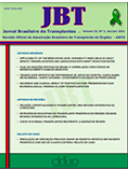Incidence and clinical impact of positive culture preservation fluid Microbiological findings in liver transplantation
DOI:
https://doi.org/10.53855/bjt.v24i2.16Keywords:
Liver Transplantation, Organ Preservation, Infection, Bacteria, FungiAbstract
Purpose: Postoperative infection is considered one of the most important causes of morbidity and mortality after liver transplantation. Few studies have examined the incidence of culture-positive preservation fluid and the outcome of related recipients. We studied the incidence and clinical impact of infections in preservation fluids for liver transplantation. Methods: We cultured Celsior preservation fluid from 225 liver transplantations for 4 consecutive years under a post-transplant infection prophylactic protocol consisting of a third generation cephalosporin plus netilmicin in high risk patients for 48 hours. Results: Seventy preservation fluids were found to be positive with one to three pathogens. Thirty-one percent of these were skin saprophytic flora; nevertheless in 29 cases (41.1%) we isolated high virulent pathogens. Only eight patients developed postoperative fever due to the pathogen isolated in the preservation fluid. Conclusion: Positive cultures of preservation fluids were observed in 31.1% patients, although one third was skin saprophytic flora. Our results do not support routine culturing of the preservation solution provided that there is an adequate antibiotic prophylactic regimen.









